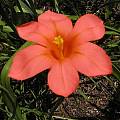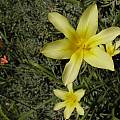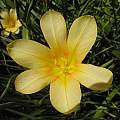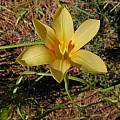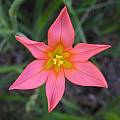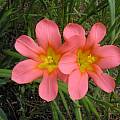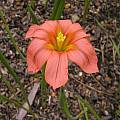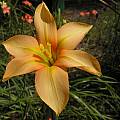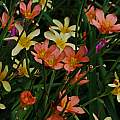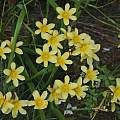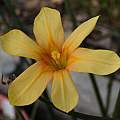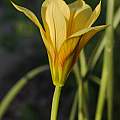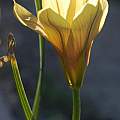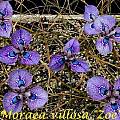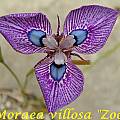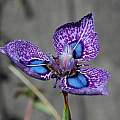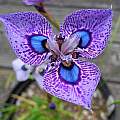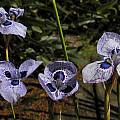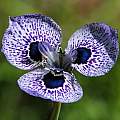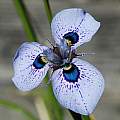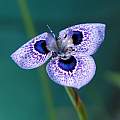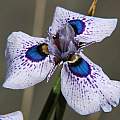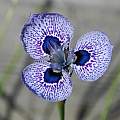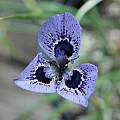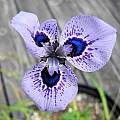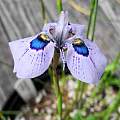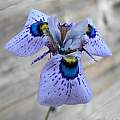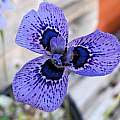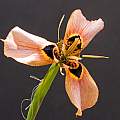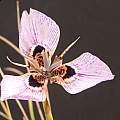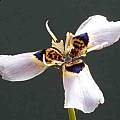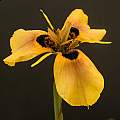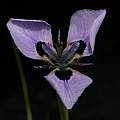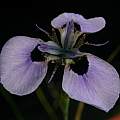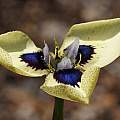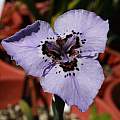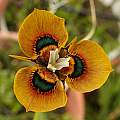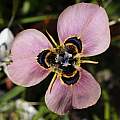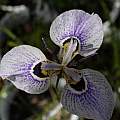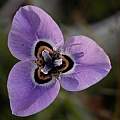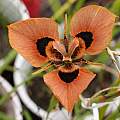Many of the species in the subgroups can be crossed to produce Moraea hybrids. Pictured on this page are some of the hybrids produced deliberately and by garden pollinators in the Homeria and the Moraea subgroups.
Homeria group hybrids
Hybrids in the Homeria subgroup have appeared in Mary Sue Ittner's coastal Northern California garden that probably have Moraea collina, Moraea flaccida or Moraeas ochroleuca in their parentage. These bloom for several months and need to be dead headed so they won't spread. They still increase by forming offset corms. All photos taken in the garden by Bob Rutemoeller.
Each flower is only open one to two days, but there is a progression of new flowers and sometimes a number are open at the same time. Shown below are apricot ones and yellow ones in mass. Photos by Mary Sue Ittner.
The photos below are of a cross between the orange form of Moraea flaccida and a yellow Homeria, probably Moraea collina. The resulting flowers are a soft peach color, with yellow centers. They have delicate veins on the backs of the tepals. Photos by Michael Mace.
Moraea group hybrids
Many species in the Moraea group can be crossed to produce interesting results. The pictures below include plants with known and unknown parentage.
Moraea 'Zoe' is probably the best-known Moraea selection, with spectacular zebra stripes on its tepals. It was grown and photographed by Bill Dijk in New Zealand, who reported that it appeared spontaneously in a patch of open-pollinated Moraea villosa plants. He named this plant Moraea villosa 'Zoe' in honor of New Zealand botanical artist Zoë Carter. It does not have a hairy stem or leaves which are important characteristics of that species, which suggests that it may be a hybrid instead of a cultivar. It shows some similarities to Moraea aristata so could be a hybrid between the two species. But there was a documented report of this color pattern showing up in a wild population of Moraea villosa (see here), and similar color patterns have occasionally shown up in private collections (here). First two photographs by Bill Dijk; second two photographs by Mary Sue Ittner who got her corms from Bill.
Seed was collected by Mary Sue Ittner of her blooming plants and grown on. She did not hand pollinate so this clone could have been further hybridized with Moraea aristata but she cannot remember if it was blooming at the same time. Below are photos of the results. The stripes remain, but not the bright purple color of the tepals. These hybrids are one of the more reliable bloomers each year in her garden which makes her happy. She is sorry however that she did not keep them all separate as some pots have corms from the original 'Zoe' and the offspring which means more interesting combinations could be created in the future since they bloom at the same time.
Moraea loubseri × unknown Moraea spp. Arthur Dawson writes: "These unintended hybrids have appeared in my collection over the last 5 years. I am reasonably certain that one parent is Moraea loubseri. Suspects for the other parents would include Moraea neopavonia, Moraea tricuspidata and perhaps Moraea papilionacea." Photos taken by Arthur Dawson.
Moraea aristata × Moraea loubseri. This is an accidental hybrid discovered in the garden of Bob Werra. The color scheme is reminiscent of M. loubseri, while the tepal shape is reminiscent of M. aristata.
Peacock Moraea hybrids. PBS member Michael Mace has been hybridizing Moraea species for several years. Some of his hybrids are shown below, and you can find many more of them here.
Galaxia - Gynandriris - Hexaglottis - Homeria A-J - Homeria K-Z - Moraea group A - Moraea group B - Moraea group C-E - Moraea group F - Moraea group G-I - Moraea group J-M - Moraea group N-R - Moraea group S - Moraea group T - Moraea group U-V - Moraea index
